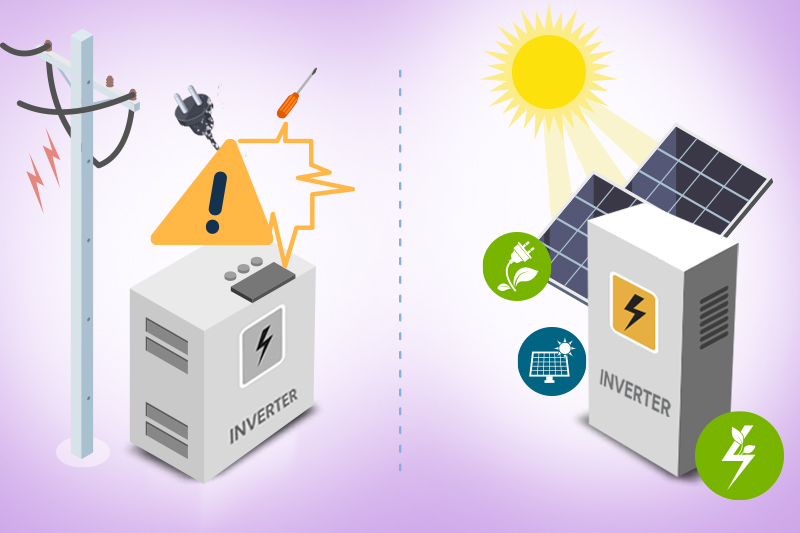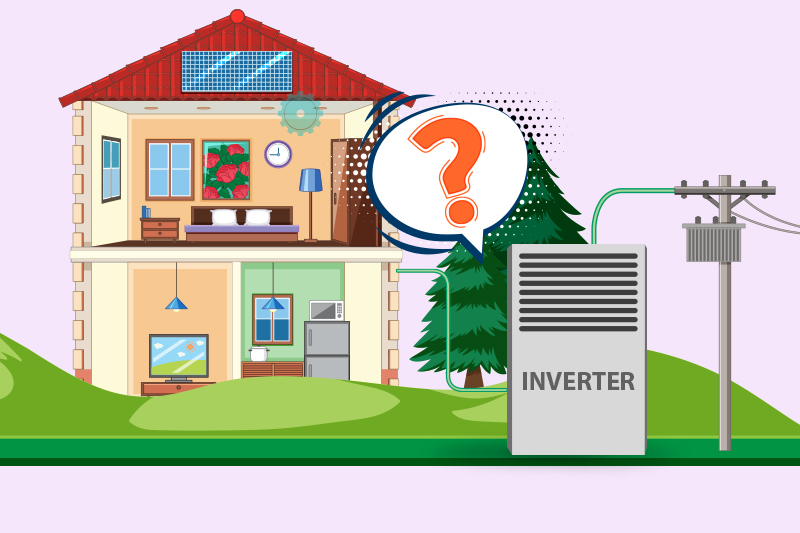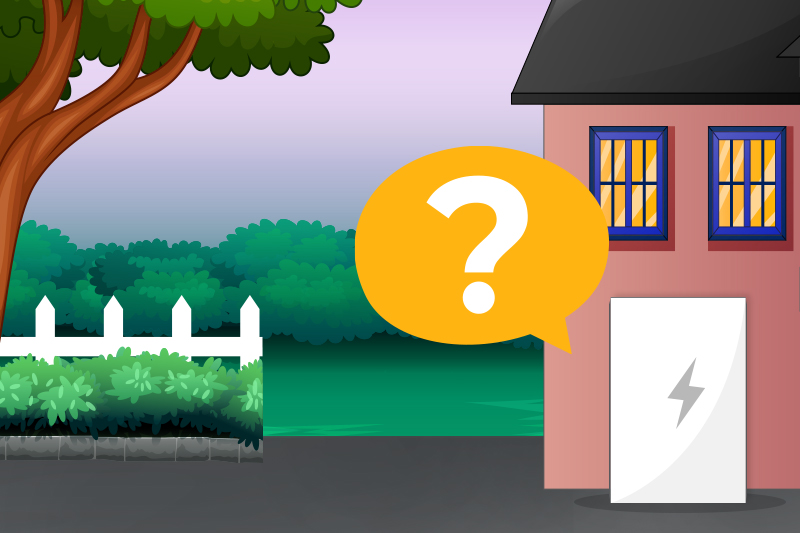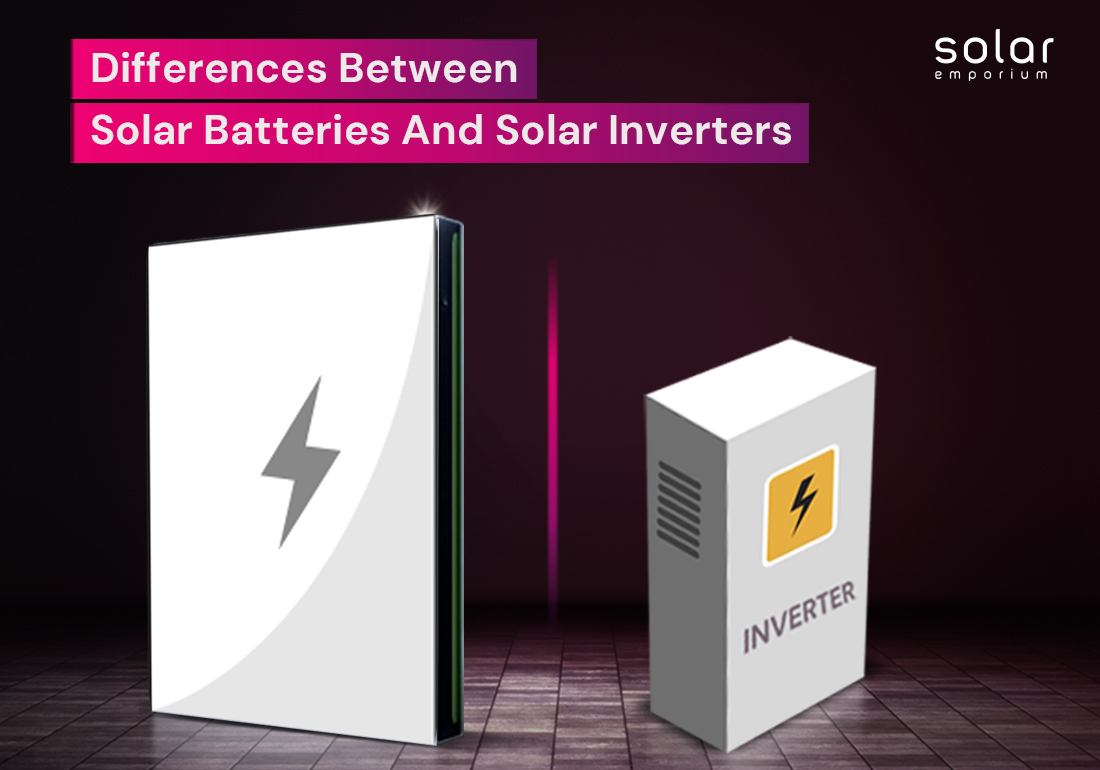Two essential components of a solar panel system are solar batteries and solar inverters. The world is increasingly turning towards renewable energy sources. Therefore, understanding the differences between these two elements is essential.
There are different roles for solar batteries and solar inverters. There are also significant differences between solar batteries and solar inverters. Today, we will explore their functionalities, significance, and how they contribute to the efficiency of solar panel systems.
What is a Solar Battery?
A solar battery is an additional component integrated into your solar energy setup. It is designed to store extra electricity produced by your solar panels.
Its purpose is to store this excess energy for later use. Solar Batteries mainly store energy when your solar panels are not actively generating electricity. Night, cloudy days, or power outages are the simple examples.
A solar battery helps you utilise more of the solar energy you generate. Without a solar storage system, any extra electricity generated by your solar panels gets directed to the grid.
It gets distributed to others instead of maximising the use of the electricity your panels initially produce.
What is a Solar Inverter?
How it works
In electricity, DC maintains a constant voltage in a single direction. At the same time, AC involves the flow of electricity in both directions within the circuit, as the voltage alternates between positive and negative. Inverters belong to the category of power electronics, a class of devices responsible for controlling the flow of electrical power.
Essentially, an inverter converts from DC to AC by rapidly waving the DC input’s direction. This process results in the transformation of a DC input into an AC output.
Moreover, by utilising filters and additional electronic mechanisms, the inverter can generate a clean, recurring sine wave that varies in voltage. This sine wave represents the pattern of voltage over time.
And it is essential for the grid’s use without causing harm to electrical equipment. Electrical devices are designed to function within specific frequencies and voltages.
The sine wave pattern produced by the inverter ensures compatibility with these requirements, safeguarding the grid and connected equipment.
Differences Between Solar Battery and Solar Inverter
Both types function as energy storage units. The primary contrast is in their charging methods and connection sources.
Solar batteries differ from inverters and undergo multiple recharging cycles directly linked to solar panels to receive and store power.
Their lifespan typically ranges between 5 and 15 years. It depends upon maintenance.
In essence, solar batteries are tailored for multiple recharges and directly acquire power from linked solar panels.
In contrast, inverters rely on chemical reactions within the unit for their power source.
Primary Differences Between Solar Battery and Inverter

- A solar storage system primarily stores power, whereas the inverter converts AC power into DC.
- During a power outage, a solar battery promptly shifts from the primary power source to back up battery power, while the inverter may have an unavoidable delay.
- A solar battery system offers standby electrical power while the inverter supplies electronic backup power.
- Battery system variations include off-line, online, and line interruption types, while inverters come in standby and grid-connected styles.
- The solar battery system connects directly to home appliances, whereas the inverter connects to the storage battery and then to the home appliance circuit.
- Solar batteries tend to be more expensive than inverters.
- Battery storage and inverter vary in providing backup power.
- Solar storage systems usually do not have minimal voltage change. Inverters may have voltage variations.
Solar Battery vs Normal Battery
A solar battery and a regular battery differ significantly.
A regular battery is typically called a deep-cycle battery. It represents a rechargeable battery extensively used in various applications, such as backup power.
These batteries store electricity and are rechargeable through multiple sources like generators or the grid. Typically composed of lead-acid, flooded-type, or sealed-type batteries, they cater to diverse functionalities.
On the contrary, a solar battery is purpose-built to store surplus electricity generated by a solar energy system.
This stored energy becomes accessible to homeowners when solar panels are inactive. Solar batteries go through numerous charge and discharge cycles.
Primarily, they are composed of lithium-ion or flow batteries. One of the significant differences between both battery types is that one specialises in solar energy systems.
A solar and a regular battery represent distinct choices for powering a solar energy system, with the former being purpose-built for storing excess solar-generated electricity.
Solar Inverter vs Regular Inverter
When you’re thinking about buying an inverter for your home or business, you might wonder about the differences between a solar inverter and a regular inverter.
But it’s more complicated to answer because many things are different. For example, how they work and the battery they use. It’s vital to understand these differences well before you decide which one to buy.
Regular Inverter Functions
The regular inverter utilises switching mechanisms to control circuits, transforming direct current (DC) to alternating current (AC). This conversion process is a fundamental objective shared by both types of inverters.
A typical power inverter draws DC power from batteries and transforms it into AC power utilised by various appliances.
Typically linked to the home’s power system, the inverter and its battery are part of this setup. When grid power is available, the batteries are charged; in the absence of grid power, the inverter usually switches to battery mode, allowing the use of essential appliances.
Solar Inverter Operations
In contrast, a solar inverter encompasses components such as solar panels, a charge controller, switching circuits, batteries, and the inverter itself.
It includes connecting appropriately rated batteries and solar panels—the inverter’s battery charges from solar panels when sufficient sunlight is available. The solar panel within a solar inverter generates variable DC, which the inverter converts into AC.
Using a solar inverter aids in reducing electricity bills and is a viable option for both residential and commercial spaces.
Integration Between Solar Panels, Batteries, and Inverters

You might be wondering about solar panels. However, many questions about the necessity of an inverter and a solar battery may arise.
Solar panels are the fundamental part of harnessing the sun’s energy. Essentially, solar panels function by collecting sunshine and transforming it into electricity. The process is straightforward.
To capture the sun’s energy, solar panels have a negatively charged side and a positively charged side. When sunlight hits the panel, it energises the electrons within, enabling them to move from the opposing side to the positive side.
However, this electricity is in its “raw” form, known as DC (direct current), whereas most household appliances operate on AC (alternating current) electricity. That’s where an inverter becomes essential.
Solar Inverter Integration
Solar inverters are crucial in transforming electricity to be accessible and secure. If solar panels represent the fuel tank, then solar inverters serve as the driving force.
While generating DC electricity is essential, its usability hinges on converting solar inverters into vital AC. This conversion is important for making electricity practical for everyday use.
These inverters significantly impact the system’s performance. Solar inverter goes beyond mere efficiency. These devices influence the quality and safety of the generated electricity.
Traditionally, most systems incorporate a single solar inverter linked to the solar panels. However, technological advancements have led to the emergence of micro-inverters.
These smaller inverters attach directly to individual solar panels, enabling personal monitoring and optimisation.
This innovation not only boosts the power output for homes but also offers a significant advantage. If one panel malfunctions, the others continue to function independently.
Solar Battery Integration

Solar batteries serve as repositories for the surplus energy in a solar panel system. While solar panels and inverters shape the core components of a PV system, adding a battery is still optional.
The primary work of a residential solar system revolves around creating energy during blackouts or saving money.
When you need a lot of energy, you might use regular power lines, which can be expensive. If you make more energy than you require, it returns to the system, and you get credits for it on your future bills.
A solar battery is like the batteries in your gadgets or cars. It stores extra electricity made by your solar panels. This stored power helps when the weather is cloudy, so you have electricity when needed. Instead of sending extra power back to the system, the battery keeps it for you.
You don’t have to get a solar battery, but it’s a good idea. It can cut your electricity bills by another 75%, besides what you save from making your energy.
If you’re getting a solar system, it’s smart to include a battery from the start. This makes the whole system work better and saves you more money.
Check out Solar Emporium and our solar packages to get the best solar products at a convenient price.

